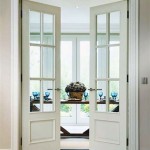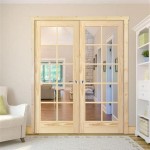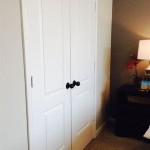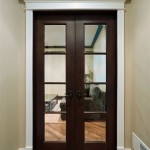Choosing the Right Paint Finish for Interior Doors and Trim
Selecting the appropriate paint finish for interior doors and trim is a decision that significantly impacts both the aesthetic appeal and the longevity of these architectural elements. The finish not only determines the sheen and texture of the painted surface but also influences its durability, cleanability, and ability to withstand wear and tear. Understanding the characteristics of different paint finishes is crucial for achieving a professional and long-lasting result.
Paint finishes are broadly categorized by their sheen level, which refers to the amount of light they reflect. This characteristic directly affects how a surface appears and how well it resists scuffs and stains. The most common paint finishes for interior doors and trim include matte, eggshell, satin, semi-gloss, and gloss. Each finish possesses unique properties that make it suitable for specific applications and environments.
The selection process should consider several factors, including the intended use of the space, the level of traffic it experiences, the existing architectural style, and personal preferences regarding aesthetics. High-traffic areas, such as hallways and entryways, necessitate more durable and easily cleanable finishes than areas with less frequent use, such as bedrooms or formal living rooms. Similarly, the architectural style may dictate a preference for a specific finish, with traditional homes often favoring higher sheen levels to accentuate intricate moldings and details. The overall goal is to balance aesthetic considerations with practical requirements to achieve a satisfactory and enduring outcome.
Durability and Cleanability Considerations
The durability and cleanability of a paint finish are critical factors, particularly for doors and trim that are subject to frequent handling and exposure to dirt and grime. Higher sheen finishes, such as semi-gloss and gloss, generally offer superior durability and cleanability compared to lower sheen finishes like matte and eggshell. This is because the higher resin content in glossier paints creates a harder, less porous surface that is more resistant to scratches, scuffs, and stains. These surfaces are also easier to wipe clean with a damp cloth, making them ideal for high-traffic areas and spaces where cleanliness is paramount.
Matte finishes, on the other hand, while offering a smooth and non-reflective appearance, tend to be less durable and more difficult to clean. Their porous surface can easily absorb stains and dirt, making them less suitable for areas prone to spills or heavy use. Similarly, eggshell finishes, although slightly more durable than matte, still require more careful cleaning and are not as resistant to scuffs as higher sheen options. The choice between durability and aesthetics often involves a compromise based on the specific needs of the space.
For doors and trim in areas frequented by children or pets, a semi-gloss or gloss finish is generally recommended due to its superior resistance to wear and tear. These finishes can withstand repeated cleaning and are less likely to show fingerprints or smudges. In contrast, for areas with less frequent use, such as bedrooms or formal dining rooms, a satin or eggshell finish may be sufficient, balancing aesthetic appeal with moderate durability. Regular cleaning and maintenance can also extend the lifespan of any paint finish, regardless of its sheen level.
Sheen Levels and Their Characteristics
Understanding the characteristics of different sheen levels is essential for making an informed decision about the appropriate paint finish for interior doors and trim. Each sheen level offers a unique combination of aesthetic qualities, durability, and cleanability, making it suitable for specific applications and environments.
Matte Paint: Matte paint has the lowest sheen level, offering a flat, non-reflective appearance. It excels at concealing imperfections on walls and creating a soft, elegant look. However, it is the least durable and most difficult to clean, making it unsuitable for high-traffic areas or surfaces prone to staining. Matte paint is often used in bedrooms or formal living rooms where durability is less of a concern.
Eggshell Paint: Eggshell paint has a slightly higher sheen level than matte, offering a subtle luster that resembles the surface of an eggshell. It provides a good balance between aesthetics and durability, making it a popular choice for living rooms, dining rooms, and hallways. Eggshell paint is more cleanable than matte but still requires gentle cleaning to avoid damaging the finish.
Satin Paint: Satin paint has a noticeable sheen that is higher than eggshell but lower than semi-gloss. It offers good durability and cleanability, making it suitable for kitchens, bathrooms, and children's rooms. Satin paint is also a good choice for trim and doors, providing a smooth, washable surface that resists scuffs and stains. It offers a good compromise between aesthetics and practicality.
Semi-Gloss Paint: Semi-gloss paint has a high sheen level that reflects light and creates a durable, easy-to-clean surface. It is ideal for trim, doors, and cabinets in kitchens, bathrooms, and laundry rooms. Semi-gloss paint is highly resistant to moisture, stains, and mildew, making it a practical choice for areas prone to humidity. Its reflective properties can also brighten up dimly lit spaces.
Gloss Paint: Gloss paint has the highest sheen level, offering a shiny, reflective surface that is extremely durable and easy to clean. It is often used for trim, doors, and furniture that require maximum protection from wear and tear. Gloss paint is highly resistant to scratches, scuffs, and stains, making it ideal for high-traffic areas and surfaces that are frequently touched. However, its high sheen can accentuate imperfections, so proper surface preparation is essential.
Surface Preparation and Application Techniques
Proper surface preparation and application techniques are crucial for achieving a professional and long-lasting paint finish on interior doors and trim. Regardless of the chosen paint finish, a well-prepared surface ensures optimal adhesion, coverage, and a smooth, uniform appearance. Inadequate preparation can lead to peeling, cracking, and other issues that compromise the durability and aesthetic appeal of the painted surface.
The first step in surface preparation is to thoroughly clean the doors and trim to remove any dirt, dust, grease, or other contaminants. This can be accomplished using a mild detergent and water, followed by a thorough rinsing and drying. For previously painted surfaces, it is essential to remove any loose or flaking paint using a scraper or sandpaper. Sanding the surface also helps to create a slightly rough texture that promotes better adhesion of the new paint.
Once the surface is clean and smooth, it is important to fill any holes, cracks, or imperfections with a suitable wood filler or spackle. Allow the filler to dry completely and then sand it smooth to blend seamlessly with the surrounding surface. Applying a primer is also highly recommended, especially for bare wood or previously painted surfaces with a different color or sheen level. Primer helps to seal the surface, improve adhesion, and ensure uniform color coverage.
When applying the paint, use high-quality brushes and rollers designed for the specific type of paint being used. Apply thin, even coats, allowing each coat to dry completely before applying the next. Avoid applying too much paint at once, as this can lead to drips, runs, and uneven coverage. For trim and doors with intricate details, use a small brush to carefully paint the edges and corners. Sanding lightly between coats can also help to create a smoother, more professional finish.
Several factors influence the application of paint. Temperature and humidity affect the drying time and can impact the smoothness of the finish. Following the manufacturer's instructions regarding application, drying times, and recommended tools is crucial for optimal results. Proper ventilation is also essential to minimize exposure to paint fumes and ensure proper drying.
Ultimately, the selection of paint finish must correlate to the desired aesthetic and level of maintenance one is willing to uphold. The glossier the sheen, the easier it is to clean and more durable it becomes, but also more prone to highlighting imperfections. A matte finish is more aesthetically pleasing to some, but requires far more diligence in cleaning. Choosing the right product for the right place is integral to a successful painting project.
The Best Paint Finish For Walls Ceilings Trims Doors More Kylie M Interiors

Best Paint For Interior Doors Finish Types Compositions

How To Paint Trim And Why Satin Is The Best Finish Our Aesthetic Abode

Painting Interior Doors A Color Southern Hospitality

The Best Paint Finish For Every Room

How To Paint Trim And Why Satin Is The Best Finish Our Aesthetic Abode

How To Paint A Door Without Brush Marks Hana S Happy Home

Pretty Interior Door Paint Colors To Inspire You

Paint Sheen Guide What Should You Use On Your Walls Trim Cabinets Etc Nadine Stay

How To Paint Doors And Best Ways Make Them Durable Bless Er House
Related Posts








